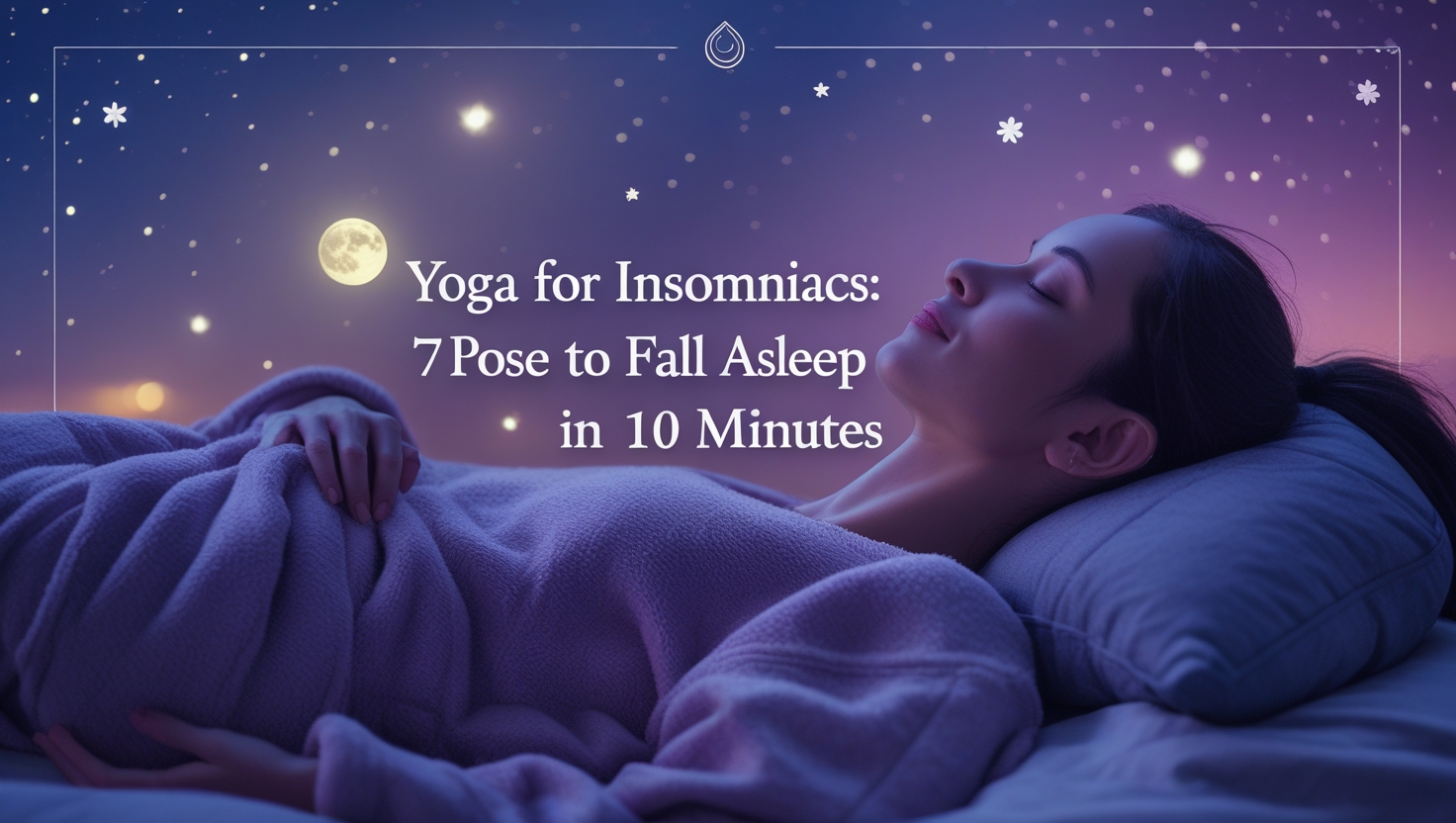Sleep is essential for overall health and well-being, yet for many, a restless night becomes all too common. If you’re among those who struggle to drift off, integrating a gentle yoga routine into your evening can be the key to unlocking deep, restorative sleep. This comprehensive guide on yoga for insomniacs presents 7 soothing poses designed to help you fall asleep in 10 minutes or less. Embrace these mindful movements, breathe deeply, and discover the calming power of yoga to quiet your mind and prepare your body for a peaceful night.
Introduction: Overcoming Insomnia with Yoga
Insomnia can disrupt every aspect of life—from concentration at work to overall mood and energy levels. When traditional methods fail, yoga offers a natural, drug-free alternative to help you relax and unwind. By focusing on gentle stretches, mindful breathing, and meditation, yoga for sleep eases the tension built up over the day and creates a tranquil state ideal for sleep.
In this guide, we’ll explore how specific yoga poses can signal your body that it’s time to rest. The practice not only stretches and relaxes the muscles but also calms the nervous system, lowering stress and anxiety that might otherwise keep you awake. Whether you’ve tried counting sheep or various sleep aids, these carefully selected poses have been designed to help you fall asleep faster—often in as little as 10 minutes.
How Yoga Can Help You Sleep
Regulating the Nervous System
Yoga works by stimulating the parasympathetic nervous system—the “rest and digest” system. Slow, mindful breathing and gentle movements lower cortisol levels, reduce heart rate, and signal to your body that it’s time to wind down.
Releasing Physical and Mental Tension
Tight muscles and a busy mind can interfere with sleep. Yoga poses target areas of tension, especially in the back, shoulders, and hips, releasing physical strain while also calming the mental chatter.
Establishing a Pre-Sleep Routine
Incorporating yoga into your nightly routine creates a consistent pre-sleep ritual. Over time, your body learns to associate these calming practices with bedtime, making it easier to transition into sleep.
Promoting Mindfulness and Relaxation
Mindfulness meditation, an integral part of yoga, helps you focus on the present moment. This mindfulness reduces worries and racing thoughts that often contribute to insomnia, creating a mental environment conducive to sleep.
7 Yoga Poses to Fall Asleep in 10 Minutes
Below are seven poses designed to gently ease you into sleep. Practice them slowly, hold each pose for several deep breaths, and allow yourself to relax with every exhale.
1. Child’s Pose (Balasana)

How to Do It:
- Begin on your hands and knees.
- Bring your big toes together and spread your knees comfortably apart.
- Sit back onto your heels and slowly lower your torso forward, resting your forehead on the mat.
- Extend your arms forward, palms down, or let them rest by your sides.
- Close your eyes, breathe deeply, and hold for 2–3 minutes.
Benefits:
- Gently stretches the back, hips, and thighs.
- Promotes a feeling of safety and relaxation.
- Calms the mind by reducing stress and fatigue.
2. Legs-Up-The-Wall Pose (Viparita Karani)

How to Do It:
- Sit close to a wall and lie on your back.
- Swing your legs up onto the wall so that they are straight and fully supported.
- Allow your arms to rest comfortably by your sides.
- Close your eyes and focus on your breath, staying in the pose for 5–10 minutes.
Benefits:
- Encourages blood circulation and reduces swelling.
- Eases tension in the legs and lower back.
- Creates a sense of calm by gently inverting the body, which soothes the nervous system.
3. Supine Twist (Supta Matsyendrasana)

How to Do It:
- Lie on your back with your legs extended.
- Bend your knees and draw them toward your chest.
- Slowly let your knees fall to one side while turning your head in the opposite direction.
- Hold for 1–2 minutes, then switch sides.
- Keep your shoulders flat on the mat and relax into the twist.
Benefits:
- Releases tension in the spine and massages abdominal organs.
- Helps improve digestion and relaxes the body.
- Provides a gentle twist that can calm the mind and ease stress.
4. Reclining Bound Angle Pose (Supta Baddha Konasana)

How to Do It:
- Lie on your back and bring the soles of your feet together, allowing your knees to drop open to the sides.
- Use pillows or bolsters under your knees if you need extra support.
- Place your arms comfortably by your sides or gently rest them on your belly.
- Close your eyes, breathe slowly, and hold for 3–5 minutes.
Benefits:
- Opens the hips and relieves tension in the groin area.
- Encourages deep relaxation and a meditative state.
- Soothes the nervous system and prepares the body for sleep.
5. Cat-Cow Stretch (Marjaryasana-Bitilasana)

How to Do It (Seated Variation):
- Sit comfortably on a chair with your feet flat on the floor.
- Place your hands on your knees.
- On an inhale, arch your back and lift your chest (Cow Pose).
- On an exhale, round your spine and tuck your chin toward your chest (Cat Pose).
- Continue to alternate slowly with your breath for 2–3 minutes.
Benefits:
- Increases spinal flexibility and releases tension in the back.
- Synchronizes movement with breath, creating a rhythmic flow that calms the mind.
- Acts as a gentle massage for the spine, preparing it for rest.
6. Forward Bend (Uttanasana) – Modified

How to Do It:
- Stand with your feet hip-width apart.
- Inhale to lengthen your spine, then exhale and gently hinge at the hips.
- Let your upper body hang down naturally, bending your knees slightly if necessary.
- Relax your neck and shoulders, and hold for 1–2 minutes while breathing slowly.
Benefits:
- Relieves tension in the back and legs.
- Helps to release the weight of the day, promoting relaxation.
- Encourages deep breathing and a meditative state that prepares you for sleep.
7. Savasana (Corpse Pose)

How to Do It:
- Lie flat on your back on a comfortable, supportive surface.
- Allow your legs to relax with a slight separation and your arms to rest gently by your sides.
- Close your eyes and focus on your breath, letting your entire body relax completely.
- Stay in the pose for 5–10 minutes, allowing every muscle to release tension.
Benefits:
- Promotes deep relaxation and a state of restfulness.
- Integrates the benefits of the preceding poses.
- Calms the mind, paving the way for a smooth transition into sleep.
Additional Tips for Using Yoga to Improve Sleep
Create a Calm Environment
- Dim the lights and eliminate distractions in your bedroom.
- Use soft music or nature sounds to create a peaceful atmosphere.
- Consider using essential oils like lavender or chamomile for their calming effects.
Establish a Consistent Routine
- Practice your yoga routine at the same time every night.
- This consistency helps signal to your body that it’s time to wind down.
- Even on busy nights, 10–15 minutes of yoga can make a significant difference.
Integrate Mindfulness and Meditation
- Focus on your breath throughout your practice.
- Allow your mind to clear by observing each inhale and exhale without judgment.
- Incorporate a short meditation session at the end of your routine to further calm your thoughts.
Avoid Stimulating Activities Before Bed
- Limit exposure to screens, caffeine, and intense exercise in the hour before sleep.
- Replace these with calming activities like reading or listening to soothing music.
Listen to Your Body
- If a particular pose doesn’t feel right, modify it or skip it altogether.
- The goal is to create a state of relaxation without strain.
- Adjust the duration of each pose to suit your comfort level.
Frequently Asked Questions (FAQs)
1. How soon can I expect to fall asleep after practicing yoga?
Many people report falling asleep within 10 minutes after completing a calming yoga routine. However, individual results vary based on factors like stress levels and overall sleep hygiene.
2. Can yoga really help with chronic insomnia?
Yes, regular yoga practice has been shown to improve sleep quality by reducing stress, balancing the nervous system, and promoting relaxation. For chronic insomnia, it’s best to combine yoga with other healthy sleep practices.
3. How long should my bedtime yoga routine be?
A well-rounded bedtime yoga routine can last anywhere from 10 to 20 minutes. Even a short session focusing on deep breathing and gentle stretches can have a significant impact on your ability to fall asleep.
4. What time of day is best for practicing yoga for sleep?
Practicing yoga about 30–60 minutes before bedtime is ideal. This timing allows your body to transition from an active state to a restful one, preparing you for sleep.
5. Do I need any special equipment for a sleep yoga routine?
A yoga mat is sufficient, but you may also benefit from props like a bolster, pillow, or blanket for added comfort during poses like Reclining Bound Angle Pose or Savasana.
6. Can yoga help improve the quality of my sleep, not just the time it takes to fall asleep?
Absolutely. Regular practice not only helps you fall asleep faster but also contributes to deeper, more restorative sleep, reducing nighttime awakenings and improving overall sleep quality.
Conclusion: Embrace the Calm and Drift Off
Incorporating yoga into your nightly routine is a gentle, natural way to combat insomnia and welcome restorative sleep. The 7 poses detailed in this guide are designed to relax both your body and mind, setting the stage for a peaceful transition into sleep—in as little as 10 minutes.
By creating a calming environment, practicing mindfulness, and consistently dedicating time to these soothing movements, you can break free from the cycle of sleepless nights and experience the rejuvenating power of quality rest. Let each pose be a step toward tranquility, and every mindful breath a promise of a night filled with deep, restorative sleep.
Step onto your mat, embrace these practices, and allow yoga to be your pathway to slumber. With commitment and gentle persistence, you can transform your bedtime routine and awaken each morning refreshed, recharged, and ready to take on the day.















Add comment